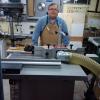Looking for input on duct design for a dust collection system. I’m moving my shop from a 400ft2 shared car garage & workshop space to a dedicated workshop space with approx 600 ft2. All of my equipment is on wheels so all easy to move around, and a few pieces like lathe I have not purchased yet so are placeholders for the future. My dust collector is a HF mod with Thien baffle (cyclone separator) with a 6” inlet and ducting is 6” sewer and drain PVC.
I've sketched out my 3 top ideas right now, see below and I'm leaning towards option #2.
Look forward to your input!




 Reply With Quote
Reply With Quote


